- KDDI HOME
 Corporate Information
Corporate Information  Investor Relations
Investor Relations  IR Documents
IR Documents  Integrated Report
Integrated Report  Selected Pages of Integrated Report (2018)
Selected Pages of Integrated Report (2018)  The Japanese Market and KDDI
The Japanese Market and KDDI
The Japanese Market and KDDI
Mobile
As of March 31, 2018, cumulative mobile communications subscriptions in Japan totaled 170.09 million [1], up 4.1% year on year.
The mobile market continues to grow, driven by the spread of smartphones and further advances in the trend of single users owning multiple devices.
There has also been significant growth in the number of service contracts for MVNO [2], up 16.0% from a year earlier to 18.40 million. The MVNO share of the mobile telecommunications market has reached 10.6% (7.4% if limited to SIM card contracts) [3], a ratio that is expected to expand further going forward. The entry of a fourth telecommunications operator is also expected in fall 2019, and Japan's mobile communications market is approaching a new stage.
Further, in the IoT field for connecting a wide variety of things with the internet, low power wide area (LPWA) specifications have been established to enable wide-area communications with low power consumption using LTE networks, and the use of IoT is ramping up across a variety of product and service fields.
Note that the scale of the overall market created by the advance of IoT is predicted to expand from ¥930 billion in 2017 to ¥4.04 trillion in 2023 [4], and expected to become the driving force in mobile communications market expansion going forward.
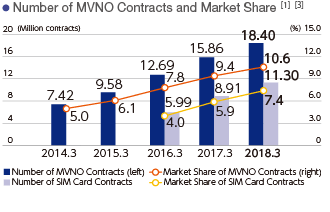

Fixed-Line Broadband
The nationwide FTTH household coverage ratio is more than 90% [5] and "homes passed [6]" is more than 70% [7], indicating that high-speed broadband environments are essentially in place nationwide.
As of March 31, 2018, fixed-line broadband service subscriptions numbered 39.35 million [1], up 1.9% from the previous fiscal year-end.
Although fixed-line broadband service penetration has reached around 70%, the market continues to expand gradually, driven by sales of discount bundled mobile and fixed-line services and the opening of new markets by new operators using the wholesaling fiber access service of NTT East and NTT West.
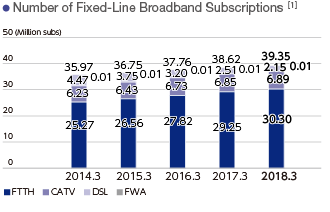
Non-Telecommunications Fields
As the domestic telecommunications business begins to shift toward a stage of stable growth, mobile telecommunications companies are working to secure new sources of revenue, utilizing their domestic telecommunications customer bases to more actively engage in a variety of initiatives aimed at expanding revenue in non-telecommunications fields such as commerce.
In addition to carrier billing, which has become a widespread means of online payment supporting that expansion, telecommunications companies are offering their own credit cards as a method of paying for offline services, creating a system for capturing both online and offline revenue. The move to cashless systems is also accelerating with advances in efforts to offer payments using QR codes.
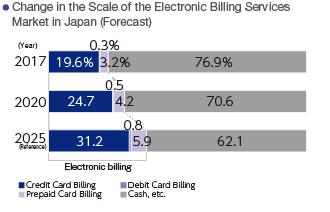
Increase in Mobile Traffic and Frequency Allocated to Each Telecommunications Company
Due to the proliferation of smartphones and tablets, and the increased performance of such devices, along with increasingly diverse mobile content services and evolution of telecommunications technologies, mobile traffic in Japan continues to grow, with both average monthly traffic and peak traffic rising by about 40% in the most recent year.
This has become an important issue for mobile telecommunications companies as they work to efficiently absorb this ongoing increase in mobile traffic and maintain stable network operations.
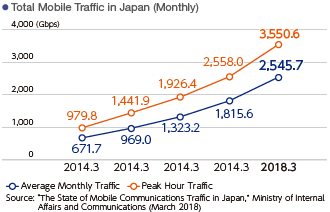
Allocation of Bandwidth among Japan's Mobile Telecommunications Operators (As of August 1, 2018)
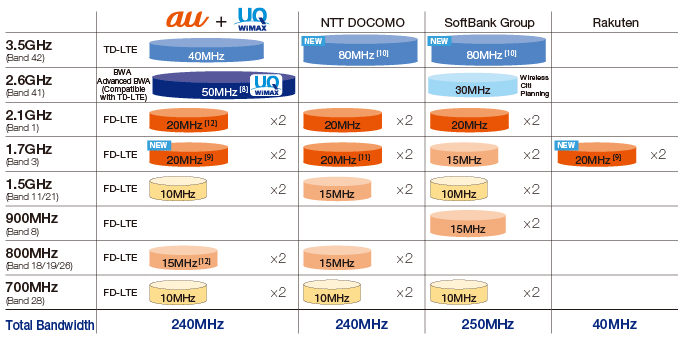
- Recommended Contents
-




